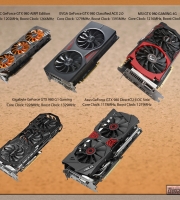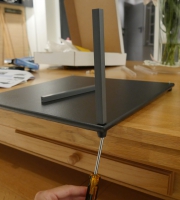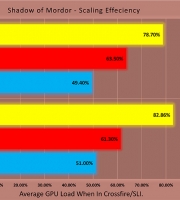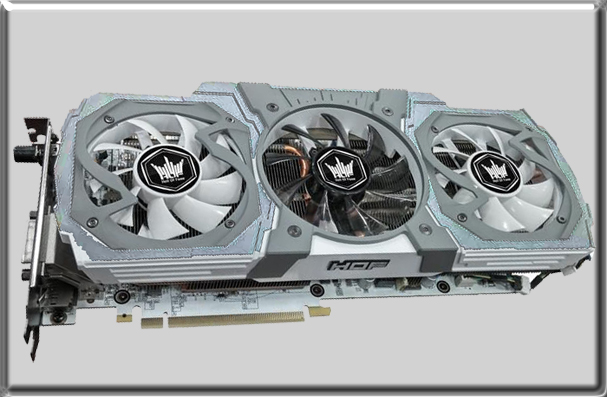


Maxwells Maxwells Everywhere and not an Grain of Coffee
Prior to winding things up, how about a cursory glance at some Gym204 Bunnies. Ha! Now that one took me five days to dream up!
My sentiments at the outset of this laboriously long winded affair were clear enough and I’ve no cause for needless negativity. Nevertheless, during its conveyance, I was struck by the flavours of these fudge, pistachio, coffee and walnut Maxwell sundaes and how little they varied from the five servings of Vanilla I sampled the week before.
When observing the image above , it is clear that manufactures were either afraid to experiment and innovate or the most efficient solution for an air cooled video card had already been established. There are five cards pictured but only two principle designs and yet, every base and boost clock value was exclusive to its host.
Memory was a common theme – 4GB and 7010mhz and any further discrepancies related to guarantees and bundled software.
Zotac also moulded a spicy “Omega” encore, which sauntered along at 1202mhz and sprinted to 1304, before excelling themselves with an interpretation of “Extreme” aplomb, and crazy cadenzas of 1291 and 1393mhz.
Significantly, these were the only paraphrases of old Green Eyes’ esteemed and ecocentric best seller to brag elevated RAM frequencies, though the gratuity was minuscule when compared to that of their cores.
The “Extreme Edition’s” over-clocking credentials were distinct from the rest, and offered direct interaction with the card’s low level settings by connecting a USB cable from the card to a front panel controller, then using the enclosed Firestorm software to access the multitude of supplementary options. It was a feature that had made its début on the company’s top tier GTX 680 two years earlier.
And sneaking in before the proof read for a spot of after hours’ Steaming , is another non-radical rework from Galaxy – previously Galaxy – a genuinely inspired and imaginative shift in brand identity. This effort was an fiendishly subtle triple fan tribute to David Hasslehoff and harboured a dual bios, upgraded capacitors and improved power distributors beneath its purring two tone fins.

Its enclosed software fostered a utility supposedly developed by amateur artisans, to bypass the Maxwell’s rigorous voltage remand. Imagine that, in the space of a few paragraphs we’ve moved from sophisticated hardware surgery apt to annul your warranty, to shamelessly promoted third party software, engineered to provide the same liberties at the vendor’s risk of indemnity.
Look, Let’s Just Escape Before they Make any More…
One last point from the present. Anybody lusting after one of these highly decorated derivatives should consider their unadorned principal has been known to attain core speeds in excess of 1500mhz (at a voltage of 1.25v) and memory frequencies grazing 7.8ghz. This was achieved via a TDP increase of 25%, the maximum endorsed by Nvida’s predetermined range.
The purpose of this reference is to offer those prone to relieve the family piggy bank of its pier and candy floss budget the chance to consider little Adam’s toffee apple and still eat their own cake. And truthfully, don’t expect to save much more.
In the world of IT, prices are driven by supply and demand to realms beyond all logic and reason. Components balanced on the brink of obsolescence can retail for double their début price solely on the basis of scarcity and to revisit this ramble’s encompassing irony, cards that are “special”, “exclusive”, “gold plated”, diamond edged, allegedly half per customer and with a sample of Vince “Kingpin” Lucido’s DNA are now easier to source than the source from which they sprung.
That’s it folks, my mind grows weary of cache, cores, and working out what tense in which I should communicate. Remember, if in doubt, panic and click purchase!